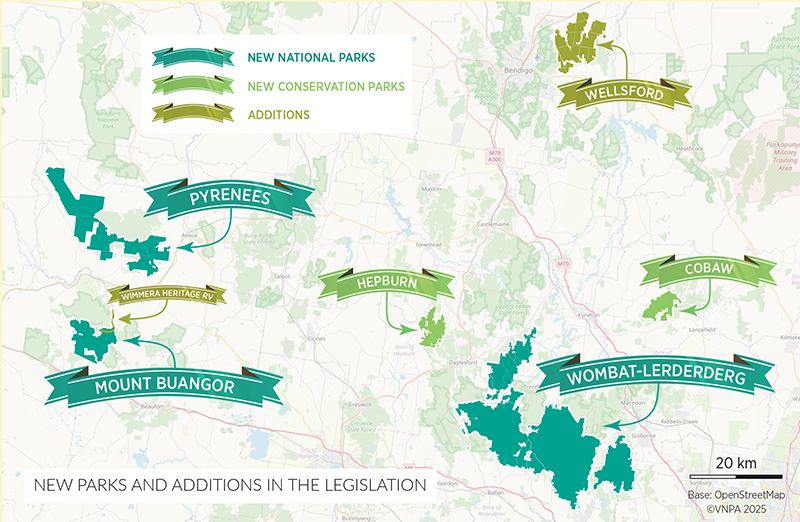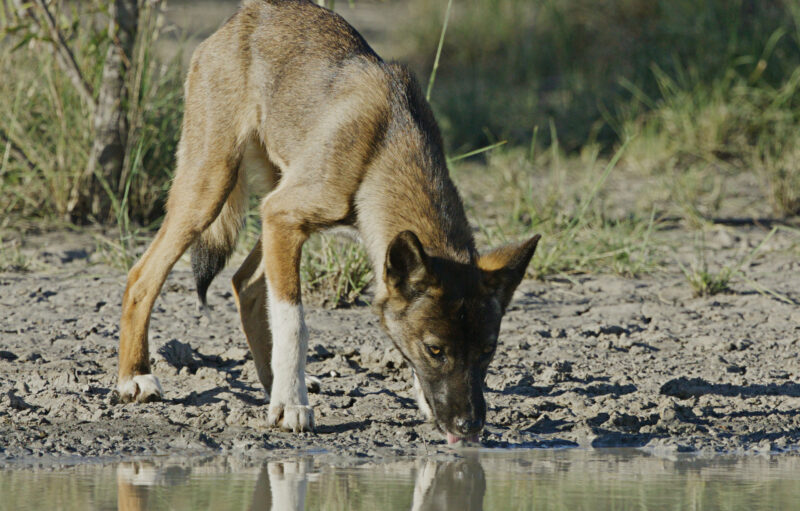PARK WATCH Article September 2025 |
After the longest of waits, the promised central west national parks are reaching the last hurdles to creation, reports Matt Ruchel, Executive Director
VNPA members and supporters are celebrating a historic win for nature, climate, and community. On 11 September, legislation for new central west national parks and conservation reserves was tabled in Victorian Parliament by Environment Minister Steve Dimopoulos.
Tell your local upper house rep to vote yes and create the parks!
The new parks will protect hundreds of rare and threatened plants, animals and fungi, including Mount Cole Grevilleas, Brush-tailed Phascogales, Mountain Skinks and Powerful Owls. The legislation fulfills several long-standing government commitments:
- Three new national parks: Wombat-Lerderderg, Mount Buangor and Pyrenees.
- Two new conservation parks: Cobaw and Hepburn.
- Expanded protection: Addition of Wellsford Forest to Bendigo Regional Park and extension of the Wimmera Heritage River around Mount Cole.
They’ll be Victoria’s first substantial new national parks in 14 long years. Places that generations of people will come and enjoy. None of it would have happened without the dedication of nature-lovers like you –the members and supporters of VNPA.
The legislation, first promised in 2021, is a result of decades of tireless advocacy to keep irreplaceable landscapes and wildlife safe from logging, resource exploitation and neglect.
This is a major milestone for Victoria’s natural heritage and climate resilience. National parks are the gold standard of protection. After four years of advocacy, we’re thrilled the legislation is finally ready. These fragmented forest remnants are vital refuges in a landscape heavily cleared for agriculture.
Premier Jacinta Allan said Victorians will be able to ‘get into nature and do the things they love including bushwalking, camping, horse riding, four-wheel driving, dog walking, fishing, seasonal deer hunting and more.’
Community voices celebrate protection
‘Wombat Forest is home to threatened wildlife, rich biodiversity and vital water catchments,’ said Gayle Osborne, spokesperson for Wombat Forestcare, who VNPA has worked closely with for over fifteen years. ‘Today’s legislation finally gives it the legal protection it deserves.’
Wendy Radford, representing community efforts as Bendigo District Environment Council said ‘Wellsford is cherished by countless visitors across the Bendigo region. Expanding protection for the whole Wellsford Forest as a regional park is a good start [though we would have preferred it to be protected as a national park, as originally recommended by VEAC]. Our beloved Box-Ironbark forests must remain a protected refuge for nature, people and our warming climate.’
The new protected areas are vital for:
- Habitat connections: Securing vital habitat for threatened wildlife like Powerful Owls and Greater Gliders.
- Water security: Protecting critical catchments supplying clean water to regional communities.
- Cultural recognition: Empowering Traditional Owner co-management and cultural authority over Country.
- Sustainable tourism: Supporting long-term nature-based recreation and economic opportunities.
- Climate resilience: Advancing carbon sequestration and climate adaptation through restored, intact ecosystems.
What happens next?
The legislation has been tabled. In October, the Legislative Assembly and then the Legislative Council will debate the bill. It has to pass through both houses for the new parks to be officially created. We will be working hard to make sure relevant parliamentarians are well briefed.
Once the legislation passes there is one final formality, the official gazettal, which bring the law into force. At this stage they become formally protected and will be handed over to Parks Victoria for management.
But there’s still work to do. These new parks will need proper funding for restoration, weed control and protection.
‘Legislation is just the beginning,’ emphasised Gayle Osborne. ‘Decades of logging and neglect have left these forests vulnerable. We need substantial investment in ecological restoration, weed and feral species control.’ Wendy Radford agreed: ‘We now need resourcing that matches the scale of the task – and the importance of what we’ve protected.’
The legislation also makes a range of small boundary amendments to other national parks and reserves and some addition updates.
Disappointingly, it also includes changes to allow deer hunting in Errinundra, Snowy River and Mt Buangor national parks, which was never in the government’s official response or recommendations from the Victorian Environmental Assessment Council (VEAC).
The legislation does not include other recommended reserves which were agreed to by the government: seven regional parks (with a recreation focus, all around Daylesford), 11 new nature conservation reserves and 18 bushland reserves, as well as some additions to existing reserves.
We have been told these will be created when new Public Land Act is passed through parliament. We will monitor this closely, as in the past smaller but high conservation value parks have been ‘forgotten’ about once the main package has been passed.
The bigger picture
The web of life we depend on is interconnected and intricate. Birds, reptiles, mammals, fish, amphibians, insects, fungi and lichen. With this news we sigh a huge breath of relief that tens of thousands of hectares of habitat are safe.
We are calling on the Victorian Government to back the parks with funding that reflects their ecological and cultural significance, so future generations can experience thriving forests, flowing rivers and abundant wildlife.
With stronger nature laws, Traditional Owner partnerships, and community support, we can now focus on proper funding and management of these precious places.
- Read the latest full edition of Park Watch magazine
- Subscribe to keep up-to-date about this and other nature issues in Victoria
- Become a member to receive Park Watch magazine in print

